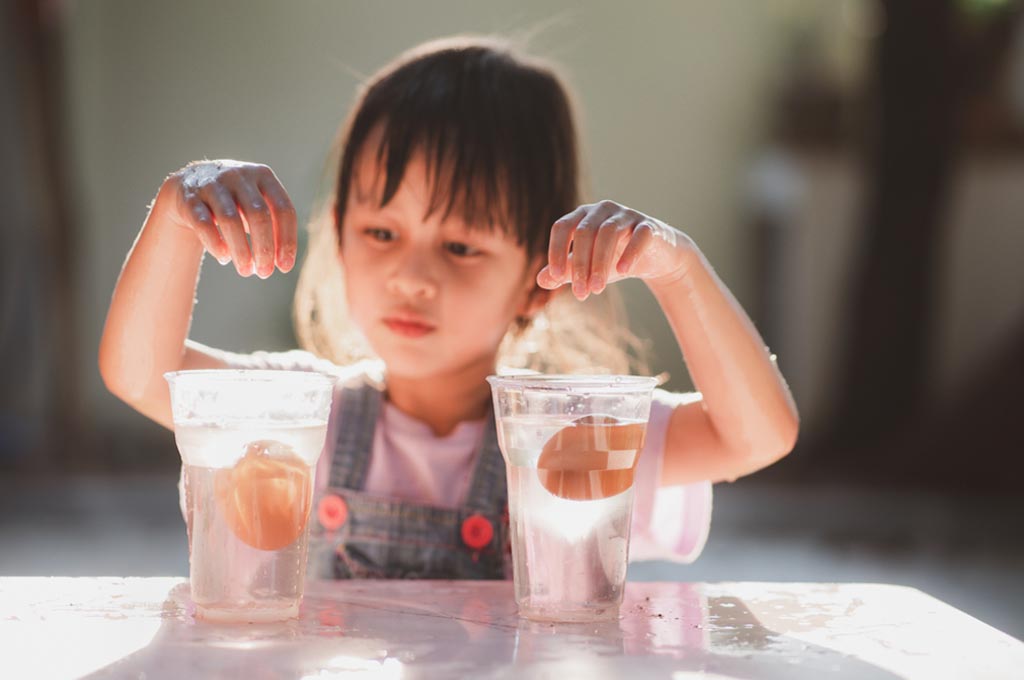When we think of activities to engage our children, our minds often default to playing with toys, imaginative play, or reading. It is less common to consider science activities as a natural part of learning, particularly in younger, preschool aged children.
Yet, research indicates learning to think scientifically at a young age can actually change young minds for the better. Science is based on learning to think critically—to ask questions, form hypotheses, test those hypotheses, and apply reasoning in discerning the results. Recent research indicates that learning critical thinking and problem solving skills are critical to future academic success, and that these skills must be explicitly taught. Other studies indicate that children who learn how to observe then explain their observations retain information better than students who only observe.
While young minds may not be ready for formal scientific instructions, they are certainly ready to learn how to draw conclusions and provide reasoning for those conclusions. They can also learn to think critically, applying their known knowledge to the conclusions of others.
Ideally, science-based preschool activities should:
- Encourage a child’s innate sense of wonder and curiosity about the natural world
- Help children develop their understanding of the world around them
- Encourage children to be problem solvers
- Introduce children to scientific reasoning (use senses to make observations, create hypotheses, look for evidence, and test predictions)
Science activities for preschool learners should be fun! They should nurture the natural, questioning spirit of children. We’ve gathered a collection of activities that will peak curiosity and have learners of all ages engaged in scientific fun.
Static Electricity Comb
This fun, hands-on experiment is perfect for teaching young learners about the concept of static electricity and cause and effect. Older children can learn about static charges, electron transfer, and positive/negative charges.
All you need for this experiment is a clear table or work surface, a plastic comb, and pieces of lightweight paper. To save time, purchase a package of the tiny tissue paper dot confetti at your local party store or online.
Color Mixing Experiment
Mixing primary colors to create secondary colors is a magical activity for young learners. In this experiment, all you need is child-safe paint (Crayola makes a great set of washable paint colors) and a few resealable plastic baggies.
Allow your child to select two primary colors (red, blue, or yellow). Have them guess what color will be created when the two colors are blended. Pour a small amount of each color in the bag and remove as much air as possible before sealing. Lay the bag on a flat surface and let your child push and move the paint around the bag until the two colors combine.
Be sure to encourage them to use their senses—how does the paint feel (cool, squishy)? What new color do you see (red and yellow make orange)?
Floaters & Sinkers
This is one of those ridiculously simple experiments that is always a smashing success amongst young learners.
If you have a water sensory table with a deep end, you can certainly use it for this experiment. Otherwise, grab a splash pool or even a plastic bin and fill with water. Gather small items from around your home (toys, corks, grapes, rocks, paper clips, cotton balls, marbles, etc.) and ask children to predict whether each item will sink or float when placed in the water.
Allow your child to drop each item in the water and describe the results. They can record their results by sorting items into smaller bins you have on hand—one for items that sink and another for the floaters. There are also plenty of free printables you can download and print out to use.
Grow, Seedlings, Grow
Gardening is exciting and interesting work for young learners, and growing seedlings is a wonderful way to introduce young learners to the idea of tending to and caring for the earth.
Before you plant your own seedlings, take your little scientist on a walk around your home, neighborhood, or local park. Ask lots of questions—what kind of plants grow in our area? What grows better in the shade? What needs full sun?
Ask children what they would like to grow…flowers? Fruits? Veggies? Once your child knows what they would like to grow, you’re ready to plant your seedlings. Follow the link above for easy-to-follow instructions for getting your seedlings off to a fantastic start.
Teaching children to interact with the world around them, to ask questions, to think critically, and to verbalise their response is not just important for becoming a good science student—it is critical to becoming a well-rounded, problem solving, critically thinking adult.
By nurturing a child’s natural interest in science, we can set them up for future academic success and a healthy adulthood.
At the end of the day knowledge is power, and helping children understand why certain foods are more nutritious than others set them up for a lifetime of healthy eating and wise food choices.
For any information about our Educational Programs, give us a call at 02 9199 0294 or fill in this contact us form.
Thanks for reading,
Clovel Childcare
1300 863 986











